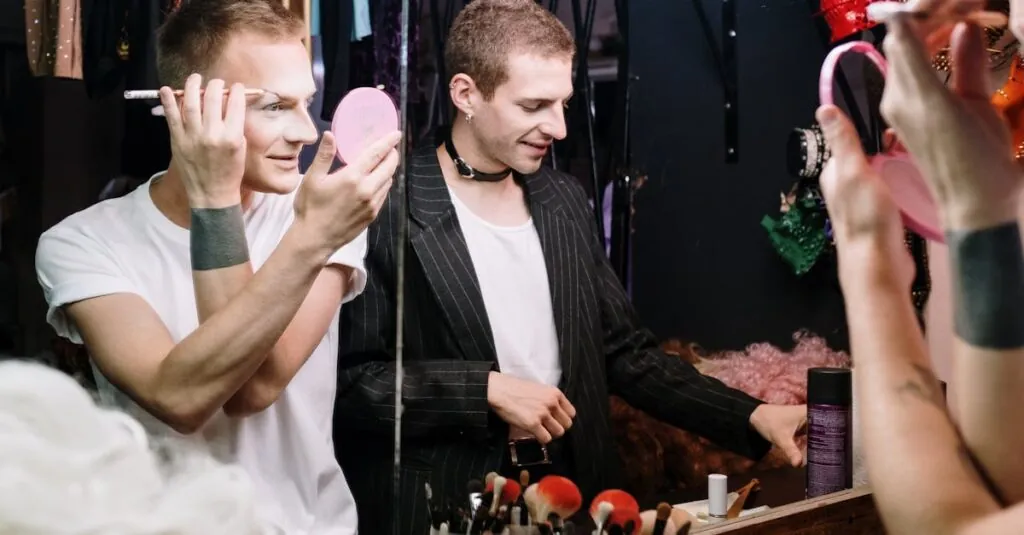Contouring can feel like a magical art form that transforms ordinary faces into stunning masterpieces. With the right techniques, anyone can sculpt their features and achieve that coveted chiseled look. But let’s be honest—without a guide, it can also resemble a messy Picasso painting gone wrong. Fear not, aspiring makeup artists!
What Is Step-By-Step Contouring?
Step-by-step contouring refers to a systematic approach to sculpting the face through makeup application. This technique enhances natural features using shades of highlight and shadow. Different products, like creams, powders, and sticks, can achieve varying effects.
The process begins with a clean, moisturized face. Following this, foundation or concealer creates an even base. Key areas targeted for contouring include the cheekbones, jawline, forehead, and nose. A darker shade, typically two to three shades deeper than the skin tone, provides depth on specific areas.
Highlighting uses lighter shades, often one to two shades brighter than the skin tone. Applying highlight along the cheekbones, brow bones, and down the center of the nose brightens the face. Correct placement of both shades creates dimension and definition.
Tools such as brushes, sponges, or fingers can assist in blending. Blending ensures a seamless transition between the highlighted and contoured areas, which prevents harsh lines.
The final step often involves setting the makeup with translucent powder. This technique locks in the look and enhances longevity throughout the day. Using these strategies results in a polished, sculpted appearance that enhances individual features.
Benefits of Step-By-Step Contouring
Step-by-step contouring provides multiple advantages for achieving a polished makeup look. This technique focuses on enhancing facial structures while ensuring an even application for all users.
Enhancing Facial Features
Contouring emphasizes unique facial attributes. Cheekbones appear more defined, and the jawline gains clarity with darker shades. Applying highlights to the brow and inner corners of the eyes brightens the overall appearance. Eyes look larger and skin radiates with strategic highlighting. Users find that subtle adjustments create significant enhancements without an overwhelming look.
Creating Dimension
Dimension in makeup brings depth to the face. Step-by-step contouring allows users to sculpt areas like the forehead and nose gracefully. Deepening shadows along the sides of the nose enhances its shape. Lighter highlighter on the bridge adds a lifted effect. Blending techniques ensure that transitions between colors appear seamless. The result is a three-dimensional appearance, evoking a natural yet refined complexity in one’s makeup look.
Tools and Products Required
Contouring requires specific tools and products to achieve a polished look. Understanding these essentials helps in creating a sculpted appearance.
Brushes and Sponges
Makeup brushes and sponges play a vital role in contouring. Dense brushes offer precision for applying contour products to specific areas, like the cheekbones and jawline. Angled brushes work well for applying contour along the nose. Soft sponges are excellent for blending products seamlessly, ensuring a natural transition between shades. A beauty blender can pack foundation and concealer into the skin, allowing for a flawless base. Ultimately, having a variety of brushes and sponges ensures versatility and control during the application process.
Contouring Products
Choosing the right contouring products is crucial for achieving a flattering look. Cream and powder formulas serve different purposes; cream contours provide a dewy finish, while powders offer a matte effect. Select a contour shade that is two to three shades darker than the natural skin tone for effective depth. Highlighters, in various finishes, enhance the skin’s luminosity. Be sure to opt for a setting powder to lock in the makeup and keep it in place throughout the day. Using the right products can make a significant difference in the overall contouring experience.
Step-By-Step Guide to Contouring
Contouring requires a systematic approach to achieve desired results. Following these steps ensures a refined and sculpted appearance.
Preparing Your Face
Start with a clean, moisturized face. Applying primer enhances makeup longevity and creates a smooth canvas. Afterward, use foundation or concealer to achieve an even skin tone. Choose a formula that matches skin type for optimal results. Allow the base products to set, ensuring a flawless application for contouring.
Applying Contour and Highlight
Select a contour shade two to three shades darker than the natural skin tone. Use a precise brush to apply contour on key areas like the cheekbones, jawline, forehead, and nose. Follow with a highlighter on areas that reflect light, such as the tops of cheekbones, brow bones, and the bridge of the nose. Applying these products strategically creates dimension, defining facial features effortlessly.
Blending Techniques
Blending is crucial for a seamless look. Use a dense brush or sponge to blend contour into the skin using circular motions. For highlights, a soft sponge ensures a smooth transition. Achieving a natural finish may require layering and blending multiple times. Make sure no harsh lines remain, allowing for a polished appearance that enhances individual features.
Common Mistakes to Avoid
Skipping the preparation of the skin is a frequent error in contouring. A clean and moisturized face ensures that products apply smoothly and last longer. Neglecting to choose the right contour shade often leads to an unnatural look. Opt for shades that are two to three tones darker than the skin to create depth without overwhelming features.
Applying too much product can create harsh lines and an unrealistic appearance. Instead, build the contour gradually to maintain control over intensity. Blending inadequately is another common issue. It’s crucial to use brushes or sponges to achieve a seamless transition between highlighted and contoured areas.
Using the wrong tools affects the final result. Dense brushes work well for precise application, while softer sponges are best for blending. Forgetting to set the makeup can lead to premature fading or shifting. Translucent powder locks in the look for enhanced longevity throughout the day.
Another mistake is not considering face shape. Tailoring the application technique to suit individual features enhances the overall contouring effect. Additionally, focusing only on traditional areas, such as cheekbones and jawline, overlooks other key spots. Highlighting the bridge of the nose and brow bone adds beauty and dimension.
Overanalyzing every detail can create unnecessary stress. Contouring should be a fun and creative process, rather than a chore. Frequent practice helps refine skills. With each attempt, confidence grows and techniques improve, leading to consistently great results.
Mastering the art of contouring can elevate any makeup routine. By following a step-by-step approach and utilizing the right tools and products, anyone can achieve a beautifully sculpted look. The key lies in preparation blending and tailoring techniques to individual features. With practice and patience contouring transforms into a fun creative process that enhances natural beauty. Embracing these techniques not only boosts confidence but also allows for personal expression in makeup artistry. So grab those brushes and start sculpting with confidence.





